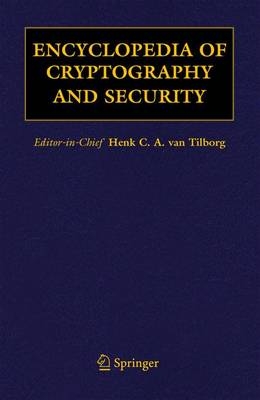
Encyclopedia of Cryptography and Security
Springer-Verlag New York Inc.
978-0-387-23473-1 (ISBN)
- Titel ist leider vergriffen;
keine Neuauflage - Artikel merken
This comprehensive encyclopedia provides easy access to information on all aspects of cryptography and security. With an A--Z format of over 460 entries, 100+ international experts provide an accessible reference for those seeking entry into any aspect of the broad fields of cryptography and information security. Most entries in this preeminent work include useful literature references, providing more than 2500 references in total. Topics for the encyclopedia were selected by a distinguished advisory board consisting of 18 of the world's leading scholars and practitioners.
Main subject areas include: Authentication and identification Block ciphers and stream ciphers Computational issues Copy protection Cryptanalysis and security Cryptographic protocols Electronic payment and digital certificates Elliptic curve cryptography Factorization algorithms and primality tests Hash functions and MACs Historical systems Identity-based cryptography Implementation aspects for smart cards and standards Key management Multiparty computations like voting schemes Public key cryptography Quantum cryptography Secret sharing schemes Sequences Web security The style of the entries in the Encyclopedia of Cryptography and Security is expository and tutorial rather than detailed and technical, making the book a practical resource for information security experts as well as professionals in other fields who need to access this vital information but who may not have time to work their way through an entire text on their topic of interest. The underlying concepts in information security can be difficult to understand and may even be counter-intuitive. The Encyclopedia of Cryptography and Security will become the premier reference work on this complex subject.
Advisory Board Members Carlisle Adams, Entrust, Inc. Friedrich Bauer, Technische Universitat Munchen Gerrit Bleumer, Francotyp-Postalia Dan Boneh, Stanford University Pascale Charpin, INRIA-Rocquencourt Claude Crepeau, McGill University Yvo Desmedt, University of London Grigory Kabatiansky, Institute for Information Transmission Problems Burt Kaliski, RSA Security Peter Landrock, University of Aarhus Patrick McDaniel, Penn State University Alfred Menezes, University of Waterloo David Naccache, Gemplus Christof Paar, Ruhr-Universitat Bochum Bart Preneel, Katholieke Universiteit Leuven Jean-Jacques Quisquater, Universite Catholique de Louvain Kazue Sako, NEC Corporation Berry Schoenmakers, Technische Universiteit Eindhoven
Preface.- Advisory board members.- List of contributors.- Acknowledgements.- A5/1.- ABA digital signature guidelines .- access control.- access structure.- acquirer.- adaptive chosen ciphertext attack.- adaptive chosen plaintext and chosen ciphertext attack.- adaptive chosen plaintext attack.- Alberti encryption.- alphabet.- anonymity.- asymmetric cryptosystem.- attribute certificate.- attributes management.- authenticated encryption.- authentication.- authentication token.- authorization architecture.- authorization management.- authorization policy.- auto-correlation.- availability.- Beaufort encryption.- Berlekamp-Massey algorithm.- Berlekamp Q matrix.- binary Euclidean algorithm .- binary exponentiation method.- binomial distribution.- biometrics.- birthday paradox.- blind signature.- blinding techniques.- block ciphers.- Blowfish.- BLS short digital signatures.- Blum integer.- Blum-Blum-Shub Pseudorandom bit generator.- Blum-Goldwasser public key encryption system.- Bolero.net.- Boolean functions.- boomerang attack.- broadcast encryption.- Caesar cipher.- Camellia.- CAST.- CBC-MAC and variants.- CCIT-2.- CEPS standard.- certificate.- certificate management.- certificate of primality.- certificate revocation.- certification authority.- certified mail.- chaffing and winnowing.- challenge-response protocol.- Chaum blind signature scheme.- Chinese Remainder Theorem.- chosen ciphertext attack.- chosen plaintext attack.- chosen plaintext-chosen ciphertext attack.- ciphertext only attack.- claw-free.- CLIP-scheme.- clock-controlled generator.- closest vector problem.- code book attack.- collision attack.- collision resistance.- combination generator.- commitment.- Common Criteria.- communication channel anonymity.- compromizing emanations.- computational complexity.- contract signing.- control vector.- copy protection.- correcting-block attack.- correlation attack for stream ciphers.- correlation-immune and resilient Boolean functions.- covert channel.- CPS, Certificate Practice Statement.- Cramer-Shoup public key scheme.- credentials .- cross-correlation.- cryptanalysis (classical).- crypto machines.- cryptology (classical).- cryptosystem.- CRYPTREC (Japanese algorithms evaluation).- cut-and-choose protocol.- cyclic codes.- Data Encryption Standard (DES).- data remanence.- Davies-Meyer.- DC Network.- de Bruijn sequence.- decisional Diffie-Hellmann problem.- decryption exponent.- deniable encryption.- denial-of-service.- derived key.- designated confirmer signature.- DES-X.- dictionary attack (1).- dictionary attack (2).- differential cryptanalysis .- differential power analysis .- differential-linear attack.- Diffie-Hellman key agreement.- Diffie-Hellman problem.- digital signature schemes.- Digital Signature Standard .- digital steganography.- discrete logarithm problem.- E0 (Bluetooth cipher).- eavesdropper.- ECC challenges .- electromagnetic attack.- electronic cash .- electronic cheque.- electronic negotiable instruments.- electronic payment.- electronic postage.- electronic voting schemes.- electronic wallet.- ElGamal digital signature scheme.- ElGamal public key encryption.- elliptic curve cryptography.- elliptic curve discrete logarithm problem .- Elliptic Curve key agreement schemes.- elliptic curve keys.- elliptic curve method for factoring.- elliptic curve point multiplication using halving.- Elliptic Curve public-key encryption schemes.- Elliptic Curve signature schemes.- elliptic curves.- elliptic curves for primality proving.- EMV-standard.- encryption.- encryption exponent.- entitlements management.- entity authentication.- Euclidean algorithm .- Euler's totient function.- exhaustive key search.- existential forgery.- exponential time.- exponentiation algorithms.- extension field.- factor base.- factoring circuits.- fail-stop signature.- fair exchange.- fast correlation attack.- fault attack.- FEAL.- Feistel cipher.- Fermat primality test.- Fermat's little theorem.- Fiat-Shamir identification protocol and Feige Fiat-Shamir signature scheme.- field.- field polynomial.- filter generator.- fingerprinting.- finite field.- FIPS 140.- firewall.- fixed-base exponentiation.- fixed-exponent exponentiation.- forgery.- gap.- generalized Mersenne prime.- generator.- GMR signature.- Goldwasser-Micali encryption scheme.- Golomb's randomness postulates.- GOST.- greatest common divisor.- group .- group key agreement.- group signature.- hard core bit.- Hardware Security Module.- hash function.- HMAC.- homomorphism.- HTTPS, secure HTTP.- IDEA.- identification.- identity based cryptosystems.- identity based encryption.- identity management.- identity verification protocol.- impersonation attack.- impossible-differential attack.- index-calculus method.- information theory.- integer factoring.- interactive argument.- interactive proof.- interpolation attack.- intrusion detection.- invasive attacks.- inversion attack.- inversion in finite fields and rings.- IPES.- IPsec.- irreducible polynomial .- issuer.- Itoh-Tsujii inversion algorithm.- Jacobi symbol.- Karatsuba algorithm.- KASUMI/MISTY1.- Kerberos authentication protocol.- key.- key agreement.- key authentication.- key encryption key.- key escrow.- key management.- knapsack cryptographic schemes.- known plaintext attack .- lattice.- lattice reduction.- lattice-based cryptography.- least common multiple.- Legendre symbol.- linear complexity (or linear equivalence).- linear congruential generator.- linear consistency attack.- linear cryptanalysis for block ciphers.- linear cryptanalysis for stream ciphers.- linear feedback shift register.- linear syndrome attack.- L-notation.- Luby-Rackoff cipher.- MAA.- MAC algorithms.- man-in-the-middle attack.- MARS.- MASH functions (Modular Arithmetic Secure Hash).- master key.- Maurer's method.- maxims.- maximum-length linear sequence.- McEliece public key cryptosystem.- MD4-MD5.- MDC2 and MDC 4 .- meet-in-the-middle attack.- Mersenne prime.- Miller-Rabin probabilistic primality test.- minimal polynomial.- MIPS-year.- miss-in-the-middle attack.- MIX networks.- modes of operation of a block cipher.- modular arithmetic.- modular root.- modulus.- MONDEX-scheme.- Montgomery arithmetic.- Moore's law.- multiparty computation.- multiple encryption.- multi-precision multiplication.- multi-precision squaring.- multi-set attacks.- Needham-Schroeder protocols.- NESSIE project.- Niederreiter encryption scheme.- non-interactive proofs .- nonlinear feedback shift register.- non-linearity of Boolean functions.- non-malleability.- non-repudiation.- non-secret key encryption.- NTRU.- Number field.- Number Field Sieve.- number theory.- Nyberg-Rueppel signature scheme.- OAEP: optimal asymmetric encryption padding.- oblivious transfer.- one-time password.- one-way function.- O-notation.- optimal extension fields.- order.- overspender detection.- overspending prevention.- Paillier encryption and signature schemes.- password.- payment card.- PEM, Privacy Enhanced Mail.- penetration testing.- perfect forward secrecy / PFS.- personal identification number (PIN).- physical attacks.- PKCS.- PKIX - Public Key Infrastructure (X.509).- Playfair cipher.- PMAC.- policy.- Polybios square encryption.- polynomial time.- Porta encryption.- preimage resistance.- Pretty Good Privacy.- primality proving algorithm.- primality test.- prime generation.- prime number.- primitive element.- privacy.- privilege management.- probabilistic primality test.- probabilistic public-key encryption.- product cipher, superencryption.- proof of knowledge vs proof of membership.- propagation characteristics of Boolean functions.- protocol.- Proton.- pseudo Mersenne primes.- pseudo-noise sequence.- pseudonyms.- pseudoprime.- pseudo-random function.- pseudo-random number generator .- public key cryptography.- Public Key Infrastructure.- public key proxy encryption.- public key proxy signatures.- quadratic residue.- Quadratic Residuosity Problem.- Quadratic Sieve.- quantum cryptography.- Rabin cryptosystem.- Rabin digital signature scheme.- radio frequency attacks.- random bit generation (hardware).- random oracle model.- RC4.- RC5.- RC6.- recipient anonymity.- Reed-Muller codes.- Registration Authority.- related key attack.- relatively prime.- relay attack.- replay attack.- response.- resynchronization attack.- rights management.- right-to-left exponentiation.- Rijndael/AES.- ring.- RIPEMD family.- RSA digital signature scheme.- RSA factoring challenge .- RSA problem.- RSA public-key encryption.- run.- running key.- safe prime.- salt.- Schnorr digital signature scheme.- Schnorr Identification Protocol .- SEAL.- second preimage resistance.- secret sharing schemes.- secure signatures from the "strong RSA" assumption.- Secure Socket Layer (SSL) .- security.- Security Architecture.- Security Evaluation Criteria.- security standards activities.- selective forgery.- self-shrinking generator.- self-synchronizing stream cipher.- semantic security.- sender anonymity.- sequences.- Serpent.- SET.- SHA family (Secure Hash Algorithm).- Shamir's threshold scheme.- Shannon's model.- share.- shortest vector problem.- shrinking generator.- side-channel analysis.- side-channel attacks.- sieving.- sieving in function fields .- signcryption.- signed digit exponentiation.- simultaneous exponentiation.- Skipjack.- slide attack.- sliding window exponentiation .- smartcard tamper resistance.- S/MIME.- smoothness.- smoothness probability.- solitaire.- SPKI.- SSH.- station-to-station protocol / STS protocol.- stream cipher.- strong prime.- strong RSA assumption.- structural cryptanalysis.- sub-exponential time.- subgroup.- subgroup cryptosystems.- substitutions and permutations.- substitution-permutation (SP) network.- summation generator.- symmetric cryptosystem.- synchronous stream cipher.- tamper detection.- tamper resistance.- tamper response.- tempest.- threshold cryptography.- threshold scheme.- threshold signature.- time stamping.- time-memory tradeoffs.- timing attack.- token.- traitor tracing.- Transport Layer Security (TLS).- trapdoor one-way function .- Triple DES.- Trojan horses, computer viruses and worms .- truncated differentials.- trust models.- trusted third party.- TWIRL.- two-factor authentication.- TWOFISH.- two-to-the-k-ary exponentiation.- undeniable signatures.- Universal One-Way Hash Functions (UOWHF).- unlinkability.- untraceability.- user authentication.- verifiable encryption.- verifiable secret sharing .- Vernam cipher.- Vigenere cryptosystem .- virus protection.- visual secret sharing scheme.- watermarking.- weak keys.- web security.- Wiener, Boneh-Durfee, and May Attacks on the RSA Public Key Cryptosystem.- witness hiding.- X.509.- zero-knowledge.- Index.
| Erscheint lt. Verlag | 6.9.2005 |
|---|---|
| Reihe/Serie | Encyclopedia of Cryptography and Security | 1.20 |
| Zusatzinfo | 1, black & white illustrations |
| Verlagsort | New York, NY |
| Sprache | englisch |
| Maße | 280 x 216 mm |
| Gewicht | 3520 g |
| Einbandart | gebunden |
| Themenwelt | Informatik ► Theorie / Studium ► Algorithmen |
| Informatik ► Theorie / Studium ► Kryptologie | |
| ISBN-10 | 0-387-23473-X / 038723473X |
| ISBN-13 | 978-0-387-23473-1 / 9780387234731 |
| Zustand | Neuware |
| Haben Sie eine Frage zum Produkt? |
aus dem Bereich


